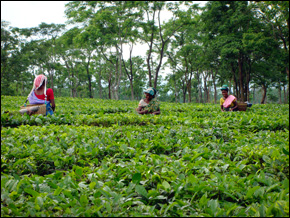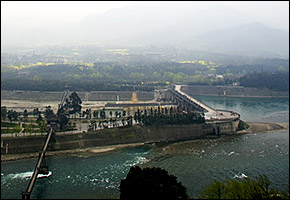Heavy Rainfall Hampers Tea Markets in India and Sri Lanka
Severe weather impacts could compromise tea farming for two of the world’s biggest players in the industry.

A tea farm in the Assam region of India.
India and Sri Lanka‘s heavy rainfall is devastating both countries’ tea industries, according to reports from Reuters.
Nearly 5000 acres could be carried away if the Brahmaputra River and others shift their flows and flood onto their banks in India, which is the world’s second largest tea growing state.
India consumes about 80 percent of its own tea harvest, more than half of which is grown in the Assam region in the northeastern part of the country. The region’s 850 tea plantations employ nearly one million people and export tea to more than 80 countries. As heavy monsoons cause the Himalayan rivers to flood into tea-growing valleys, shortages in the international tea market could occur later this year.
In 2009 the Southeast Asian country exported nearly a billion kilograms of tea, generating about one-half of a billion dollars in revenue.
Meanwhile in neighboring Sri Lanka, which is the world’s fourth largest tea producer, prices have rebounded from heavy rainfall last month. Although this quarter the country has experienced a 27 percent increase in tea production over the same compared to last year, in April the market experienced a 7.5 percent drop, according to Reuters. Lanka Business Online also reported last week that tea prices may have “bottomed out” in May, as brokers worried heavy rains would reduce crops in the south, where the majority of the country’s tea is grown. But as rainfall receded, prices rose to around 40 cents per kilogram.
Last year’s revenue from tea fell to $US1.2 billion from $US1.4 billion in 2008, and is expected to come in around $US1.3 billion by the end of 2010. The industry makes up 15 percent of Sri Lanka’s GDP and occupies 4 percent of the country’s land.
Despite the rain, Agalawatte Plantations–a major tea cultivator, producer and processor–saw tea profits increase compared to this time last year, according to Lanka Business Online. Founded 18 years ago, Agalawatte is a subsidiary of Mackwoods Plantations, an 169-year-old distributor that houses 27,000 acres of tea. Profits for the subsidiary were posted at 1.9 million rupees ($US40,000) as compared with losses of 13 million ($US280,000) last year.
In 2009, Sri Lanka increased the amount of tea exported to India by 136 percent because of changes that lightened some governmental regulations in a 10-year-old free trade agreement, according to Lanka Business Online. If India’s weather conditions do not subside soon, it’s possible that this export trend from Sri Lanka to India could continue.
Sources: Reuters, Lanka Business Online,

is a Traverse City-based assistant editor for Circle of Blue. She specializes in data visualization.
Interests: Latin America, Social Media, Science, Health, Indigenous Peoples










Leave a Reply
Want to join the discussion?Feel free to contribute!